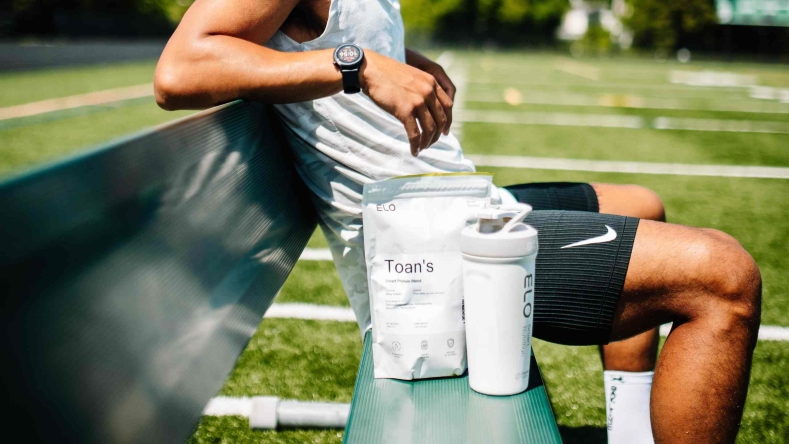The ultimate guide to intermittent fasting and running
Intermittent fasting has become one of the latest buzzwords in the health and wellness space. But why are people talking about it, and is there a way to safely fast, especially for runners? Here’s everything you need to know about intermittent fasting and running.

Named the most popular diet of 2020 in a study by the International Food Information Council, intermittent fasting (IF) has become a favorite way for many to manage their weight and improve their health [ 1
Contrary to most other diets, intermittent fasting puts more focus on when you eat rather than what you eat. Though it can be done in several different ways, all types of intermittent fasting incorporate periods of eating and fasting throughout the day or week.
While depriving your body of essential nutrients and energy doesn’t seem healthy, preclinical studies and clinical trials show that intermittent fasting has broad benefits for many health conditions, including obesity, diabetes, heart disease, certain cancers, and neurologic disorders [ 2
Given its potential to improve total body composition through weight loss, intermittent fasting has also gained popularity among athletes seeking to get lighter, leaner, and take their athletic performance to the next level. But can intermittent fasting benefit runners, or does it do more harm than good?
Before we explore how intermittent fasting affects running performance, let’s take a closer look at what it is, what happens to your body when you fast, and who shouldn’t fast.
What is intermittent fasting?
Intermittent fasting is a dietary approach centered around eating and fasting for specific periods of time throughout the day or week. Many believe this dietary approach more closely mimics the eating patterns of our hunter-gatherer ancestors, who frequently had to go without food for extended amounts of time. Unlike other popular diets with strict food and nutrient requirements, time is the only real restriction with IF — which many people seem to like.
Types of intermittent fasting
All variations of intermittent fasting split either the day or week into eating and fasting periods. Here are the three most common types of intermittent fasting.
Time-restricted feeding (TRF): Commonly referred to as the 16:8 Method, time-restricted feeding typically involves limiting your daily eating window to 8 hours followed by a 16-hour overnight fast.
Whole-day fasting (aka the 5/2 Diet or Eat-Stop-Eat): With whole-day fasting, you typically fast for two, non-consecutive days each week, and eat normally the other five days. Some whole-day fasting programs, like the 5/2 Diet, allow you to eat 500-600 calories on fasting days, while others, like Eat-Stop-Eat, recommend zero energy intake for a full 24 hours.
Alternate day fasting: With alternate day fasting, you fast every other day, typically eating freely on the non-fasting days, and consuming about 25% of your daily calorie needs on fasting days.

What happens to your body when you fast
Whether you choose time-restricted feeding, whole-day fasting, or alternate-day fasting approach, your body moves through a fed-fast cycle, resulting in changes to both your hormone levels and metabolism. Here’s what happens to your body when you fast.
Fed State (0-3 hours after your last meal)
In the fed state, your body digests and absorbs nutrients from food. As your body absorbs nutrients, blood sugar levels and insulin secretion increase. Insulin helps transport glucose (sugar) from the blood into cells to be used or stored for energy. Excess glucose that is not immediately used for energy is either stored as glycogen in the muscles and liver or converted into triglycerides and stored as fat. During and immediately after a meal, there is a natural shift in your body’s hunger (ghrelin) and satiety (leptin) hormones. Just before a meal, ghrelin levels increase to stimulate hunger. After a meal, ghrelin levels decrease while leptin (your primary satiety hormone) increases, helping you feel full and satisfied.
Early Fasting State (3-18 hours after your last meal)
The size and composition of your last meal affect how long you remain in the fed state, but typically your body will begin to enter the Early Fasting State 3-4 hours after your last meal. As your body transitions from fed to early fasting, insulin levels decrease in the absence of carbohydrates (sugar) from food. Meanwhile, ghrelin increases as leptin decreases. Without food, your body begins to tap into its energy stores. Muscle and liver glycogen are used first and converted back into glucose. As glycogen stores deplete, the body ramps up lipolysis, converting fat into triglycerides as an alternate fuel source. As lipolysis increases, the body also breaks down protein (including muscle tissue) as a source of glucose for the brain and red blood cells, which rely heavily, or exclusively, on glucose for energy.
Fasting State (18-48 hours after your last meal)
Around the 18-hour mark, your body will go into full-on fasting mode. At this point, your body’s glycogen stores are fully depleted, leaving fat and protein its main sources of energy. With insulin levels low, some fatty acids in the blood are converted into ketones, and, at this point, your body starts to transition into ketosis. How fast this happens depends on the composition of your usual diet and your last meal. If you typically lean lower-carb, ketosis will kick in on the earlier side, around 18-24 hours.
Prolonged Fasting (48+ hours after your last meal)
Fasting for more than 2 days (48 hours) is considered prolonged, or long-term, fasting. During this stage, the body relies increasingly on ketones and muscle protein for sustained energy. Going without food for this amount of time is not recommended for most people, and should only be done under medical supervision.
Adaptive cellular responses to fasting
In addition to the hormone and metabolic changes, fasting also triggers some beneficial adaptive cellular responses that lead to reduced inflammation, oxidative stress, improved stress resistance, and the repair and/or removal of aging or damaged cells [ 2 3 2 3 4
Who should not fast
Even with all of these benefits, intermittent fasting isn’t for everyone. Because it interferes with caloric intake, you shouldn’t fast if you are underweight, have a hard time gaining weight, have a history of disordered eating, or are pregnant or breastfeeding. If you have diabetes, high blood pressure, or heart disease, fasting can have some dangerous side effects, like low blood sugar and certain electrolyte imbalances. Before making any major changes to your diet or eating regimen, check with a doctor or dietitian to make sure it’s safe and minimize your risk for complications.
Health benefits of intermittent fasting
Intermittent fasting can have some big health benefits. Regardless of whether you prefer a daily fast like the 16/8 Method or a weekly approach like the 5/2 Diet, intermittent fasting can help you lose weight and reduce dangerous visceral fat in the abdomen (aka the “spare tire”) that surrounds internal organs [ 5
Research also shows IF can improve metabolic health and blood sugar control by reducing insulin resistance, blood glucose, and fasting insulin levels — all of which may help prevent, delay, or lessen the severity of type 2 diabetes [ 3 5
Besides being good for weight loss and blood sugar control, intermittent fasting has also been shown to reduce inflammation and oxidative stress, lower blood pressure, triglycerides, and cholesterol, as well as slow the aging process and related diseases, like Alzheimer’s, and potentially increase longevity 2 3 3

Pros & cons of intermittent fasting for runners
Like any diet, intermittent fasting has some positive and negative aspects. Here are the pros and cons of intermittent fasting.
Pros of intermittent fasting for runners
Improved body composition with sustained performance.
In one small study, male elite runners following a 16:8 fasting schedule lost weight and improved their body composition while maintaining their pre-intermittent fasting performance [ 8
There’s more than one way to fast.
Another positive of intermittent fasting is that there’s more than one way to do it. Whether you prefer a daily or weekly approach, intermittent fasting can fit into your active lifestyle.
Don’t feel hungry first thing in the morning? The 16/8 Method might come fairly easy — especially if you’re already a regular breakfast-skipper. Love your weekend brunches, lunches, and dinners out? The 5/2 Diet might be a better fit since you could fast during the week and have your weekends to fully enjoy.
No foods are off-limits.
With intermittent fasting, time is the only restriction. Many people find this approach more manageable and easier to stick with than other diets that leave you longing for calories, carbs, or full-fat creamer. Another thing that makes intermittent fasting easier to stick with? You’ll spend less time in the kitchen and have fewer dirty dishes to clean up each day.
Cons of intermittent fasting for runners
Fasting might not feel so good at first.
When you start fasting, you likely expect to feel hungry, but there are some other unpleasant (but common) side effects as well, including headaches, lightheadedness, digestive upset, intense cravings, irritability, fatigue, and dehydration. It can also disrupt your sleep and, if not done properly, can also lead to malnutrition.
The good news is that, as your body adapts to the fed-fast cycle, many of these side effects ease up over time. Staying well hydrated during fasts and filling up on a variety of nutritious foods during your feeding window can help minimize some of the negative side effects of intermittent fasting.
It requires some planning and prep — especially for athletes.
Since you can’t just eat whenever hunger strikes, intermittent fasting will likely take a bit more planning — at least in the beginning. You’ll want to start your fast on a full stomach, which might mean planning or preparing a meal in advance when you have a busy day or week ahead.
If you’re fasting and running, you’ll need to factor your fed and fasting cycles into your training schedule, since nutrient timing is a crucial factor in both performance and recovery. Here’s more on whether you should eat before a morning run post-workout nutrition
Check out our intermittent fasting tips for runners at the end of this guide.
It may not be as beneficial for women.
To date, the vast majority of intermittent fasting studies have focused on men. While the research on its effects on women is slim, there is some evidence that IF may not be as beneficial for women.
One small study compared non-obese men and women who followed an alternate-day fasting regimen for three weeks and showed improved insulin sensitivity in men, but worsened blood sugar control in women [ 6
There are also a number of anecdotal reports of women who have experienced changes to their menstrual cycle or have lost their periods altogether after starting intermittent fasting.
The female body is extremely sensitive to calorie restriction, thus women should be cautious and ease into intermittent fasting. If you’re a woman, start with shorter fasting windows (increasing over time if tolerated) and stop fasting if there is any disruption to your regular menstrual cycle.

Tips for running and intermittent fasting
Whether you want to lose a little weight, lean out, or simplify your approach to healthy eating with IF, it’s possible to do so without sacrificing running performance. Here are some tips for running while fasting to help you run your best with intermittent fasting.
Ease into it. Exercise puts high energy demands on your body. By easing into intermittent fasting, you will allow your body to adjust and learn how to safely fast around exercise. Rather than going for a full 24 or 16-hour fast from the get-go, start with 10-12 hours a couple of times per week and figure out what works best for you over time.
Keep tabs on your fluid and nutrient intake. If you’re highly active, it can be challenging to eat and drink enough while intermittent fasting. Make sure you’re getting enough protein and calories during feeding windows to avoid unwanted weight and muscle loss and stay well hydrated, especially during fasting windows. Consider taking a daily multivitamin to help fill any fasting-related vitamin and mineral gaps in your diet.
Keep fasted workouts low-intensity. Fasting and training can be dangerous when done together. Schedule higher-intensity workouts for non-fasting days and keep fasted workouts low-intensity. Better yet, take a rest day when fasting.
Refuel after a fast. Fasted training likely won’t help improve your performance, so be sure to refuel after a fast, and at least 2-3 hours before a post-fast run. Not only will waiting a bit minimize the chance of tummy troubles, but it will also give your body time to rebuild depleted glycogen stores so you feel and perform your best. Here’s everything you need to know about
post-workout nutrition
, including the essential nutrients and supplements that can boost recovery and improve performanceDon’t forget to strength train. To minimize potential muscle loss associated with weight loss, incorporate regular strength and/or resistance training into your running regimen, and be sure to refuel muscles with adequate protein and carbohydrates for optimal muscle repair and recovery.
Don’t lose sleep. Sleep is crucial to athletic performance and recovery, as well as hormonal regulation. Because fasting can negatively affect sleep, it’s important to ensure you’re getting enough shuteye. If fasting keeps you awake at night, consider shortening your fasting periods.
Keep eating like an athlete. In order to perform like an athlete, you’ve got to eat like one. While your eating schedule may change a bit when fasting, the macronutrient composition of the foods you eat before, during, and after a run should continue to support exercise performance and recovery.

Recover smarter with Elo Smart Protein
When you’re intermittent fasting, how you refuel after a run can have a big impact on how quickly your body recovers. Elo Smart Protein is perfect for intermittent fasting runners of any age who want to maximize post-run recovery. Each blend is hand-mixed just for you and is optimized to deliver the right amount of protein, and key amino acids after each workout to help you recover faster. Adding a carbohydrate boost (branched cyclic dextrin or oat starch) will help replenish energy stores as well. Think of it as a supplement and protein powder in one scoop, uniquely designed for you and your recovery needs. Learn more about how it can enhance your recovery
FAQs on intermittent fasting for athletes
Intermittent fasting has been heavily studied for its impact on overall health, particularly in obese/overweight and diabetic populations. Though research on intermittent fasting for athletes is limited, some studies show it’s possible to sustain performance and improve body composition, as well as reduce inflammation, and improve immunity.
What are the effects of intermittent fasting and athletic performance?
If you are looking to lose weight and lean out without compromising performance, studies on athletes show intermittent fasting might be an effective strategy.
One randomized controlled trial found elite cyclists given an 8-hour feeding window lost weight, improved their body composition, and performed equally as well during a 4-week high-level training period. The fasting group also saw increases in peak power output/body weight ratio due to weight loss. The study also found time restrictive eating (TRE) may be beneficial for reducing inflammation and have a protective effect on some components of the immune system, which athletes may benefit from [ 7
A number of studies have also been conducted on athletes who fast from sun up to sun down during Ramadan. While the Ramadan fasting schedule is the opposite of the typical TRF overnight fast, the research shows that athletes who maintain non-fasting energy and macronutrient intake, training load, body composition, and sleep length and quality typically do not experience any substantial performance losses while fasting during Ramadan [ 9
Given the research, it’s possible to maintain your performance while intermittent fasting as long as your overall nutrition intake, training, and sleep are not negatively impacted.
While it’s safe for athletes to practice IF, endurance athletes should avoid high-intensity training while fasting since the combination can have some dangerous consequences and negatively impact long-term performance and recovery.
Can you improve endurance while intermittent fasting?
Running in a fasted state will certainly hurt your short-term endurance, but can training while fasting boost performance when you compete with a full tank?
The “train low, compete high” concept explores the idea that fasted training triggers beneficial adaptations that improve efficiency and performance in a fully fueled state. While many athletes have tested this concept in recent years, there is little evidence that fasted endurance training improves endurance levels [ 10
While IF may not improve your endurance from a “train low, compete high” perspective, it seems you can maintain your current performance as long as you prioritize your nutrition intake, training, and sleep [ 9
Can you gain muscle while intermittent fasting?
To date, there is very limited research on whether or not it is possible to gain muscle while intermittent fasting, largely because most of the research so far has focused on weight loss and metabolic health.
So far, the research evaluating the impact of intermittent fasting on body composition, and specifically muscle gain, in active individuals has shown mixed results.
One small, randomized trial found TRE did not hinder resistance training adaptations in resistance-trained females. These results suggest similar increases in muscle gains and muscular performance improvements can be achieved with different feeding regimens that contain similar energy and protein content during resistance training [ 11
Another small study in healthy men looked at the impact of TRF on weight training. In this study, the men, who had not previously weight trained, followed either a normal diet or a 4-hour time-restricted eating program four days per week. The time-restricted feeding group was able to maintain their lean body mass and increase their strength, but the normal diet group increased their strength and also gained five pounds of lean mass during the eight-week trial [ 12
Fasting can make it difficult to get enough calories and protein that are needed to build muscle, and can also interfere with the timing and frequency of protein intake that promotes muscle building and repair. While it isn’t impossible to gain muscle with intermittent fasting, it may not be the easiest diet for doing so.
Summary
Intermittent fasting has emerged as a popular dietary strategy and offers runners a unique approach to weight management and potential health benefits. While it can help improve body composition and metabolic health, fasting and running does require careful planning and may have lesser benefits for women. When implemented carefully, intermittent fasting can complement a runner's lifestyle and performance without compromising overall health.
Disclaimer: The text, images, videos, and other media on this page are provided for informational purposes only and are not intended to treat, diagnose or replace personalized medical care.
Key takeaways
Intermittent fasting has broad benefits for many health conditions, including obesity, diabetes, heart disease, certain cancers, and neurologic disorders [
2
].You shouldn’t fast if you are underweight, have a hard time gaining weight, have a history of disordered eating, or are pregnant or breastfeeding.
Research shows IF can improve metabolic health and blood sugar control by reducing insulin resistance, blood glucose, and fasting insulin levels [3, 5].
You can maintain your current running performance with IF as long as you prioritize your nutrition intake, training, and sleep [9].
Pre-workout
andpost-workout nutrition
should be optimized to support exercise performance and recovery.Elo Smart Protein
can be a convenient and cost-efficient way to boost protein and carbohydrate intake after a run to deliver the right amount of nutrients to optimize your recovery.
References
International Food Information Council. (2020b, June). 2020 Food & Health Survey. https://foodinsight.org/wp-content/uploads/2020/06/IFIC-Food-and-Health-Survey-2020.pdf
de Cabo, R., & Mattson, M. P. (2019). Effects of Intermittent Fasting on Health, Aging, and Disease. The New England journal of medicine, 381(26), 2541–2551.
https://doi.org/10.1056/NEJMra1905136
Longo, V. D., & Mattson, M. P. (2014). Fasting: molecular mechanisms and clinical applications. Cell metabolism, 19(2), 181–192. https://doi.org/10.1016/j.cmet.2013.12.008
Mattson, M. P., Longo, V. D., & Harvie, M. (2017). Impact of intermittent fasting on health and disease processes. Ageing research reviews, 39, 46–58.
https://doi.org/10.1016/j.arr.2016.10.005
Barnosky AR, Hoddy KK, Unterman TG, Varady KA. Intermittent fasting vs daily calorie restriction for type 2 diabetes prevention: a review of human findings. Transl Res. 2014 Oct;164(4):302-11. doi: 10.1016/j.trsl.2014.05.013. Epub 2014 Jun 12. PMID: 24993615.
Heilbronn, L. K., Civitarese, A. E., Bogacka, I., Smith, S. R., Hulver, M., & Ravussin, E. (2005). Glucose tolerance and skeletal muscle gene expression in response to alternate day fasting. Obesity research, 13(3), 574–581.
https://doi.org/10.1038/oby.2005.61
Moro, T., Tinsley, G., Longo, G., Grigoletto, D., Bianco, A., Ferraris, C., Guglielmetti, M., Veneto, A., Tagliabue, A., Marcolin, G., & Paoli, A. (2020). Time-restricted eating effects on performance, immune function, and body composition in elite cyclists: a randomized controlled trial. Journal of the International Society of Sports Nutrition, 17(1), 65.
https://doi.org/10.1186/s12970-020-00396-z
Brady, A. J., Langton, H. M., Mulligan, M., & Egan, B. (2021). Effects of 8 wk of 16:8 Time-restricted Eating in Male Middle- and Long-Distance Runners. Medicine and science in sports and exercise, 53(3), 633–642.
https://doi.org/10.1249/MSS.0000000000002488
Chaouachi, A., Leiper, J. B., Chtourou, H., Aziz, A. R., & Chamari, K. (2012). The effects of Ramadan intermittent fasting on athletic performance: recommendations for the maintenance of physical fitness. Journal of sports sciences, 30 Suppl 1, S53–S73.
https://doi.org/10.1080/02640414.2012.698297
Zouhal, H., Saeidi, A., Salhi, A., Li, H., Essop, M. F., Laher, I., Rhibi, F., Amani-Shalamzari, S., & Ben Abderrahman, A. (2020). Exercise Training and Fasting: Current Insights. Open access journal of sports medicine, 11, 1–28.
https://doi.org/10.2147/OAJSM.S224919
Tinsley, G. M., Moore, M. L., Graybeal, A. J., Paoli, A., Kim, Y., Gonzales, J. U., Harry, J. R., VanDusseldorp, T. A., Kennedy, D. N., & Cruz, M. R. (2019). Time-restricted feeding plus resistance training in active females: a randomized trial. The American journal of clinical nutrition, 110(3), 628–640.
https://doi.org/10.1093/ajcn/nqz126
Tinsley, G. M., Forsse, J. S., Butler, N. K., Paoli, A., Bane, A. A., La Bounty, P. M., Morgan, G. B., & Grandjean, P. W. (2017). Time-restricted feeding in young men performing resistance training: A randomized controlled trial. European journal of sport science, 17(2), 200–207.
https://doi.org/10.1080/17461391.2016.1223173





